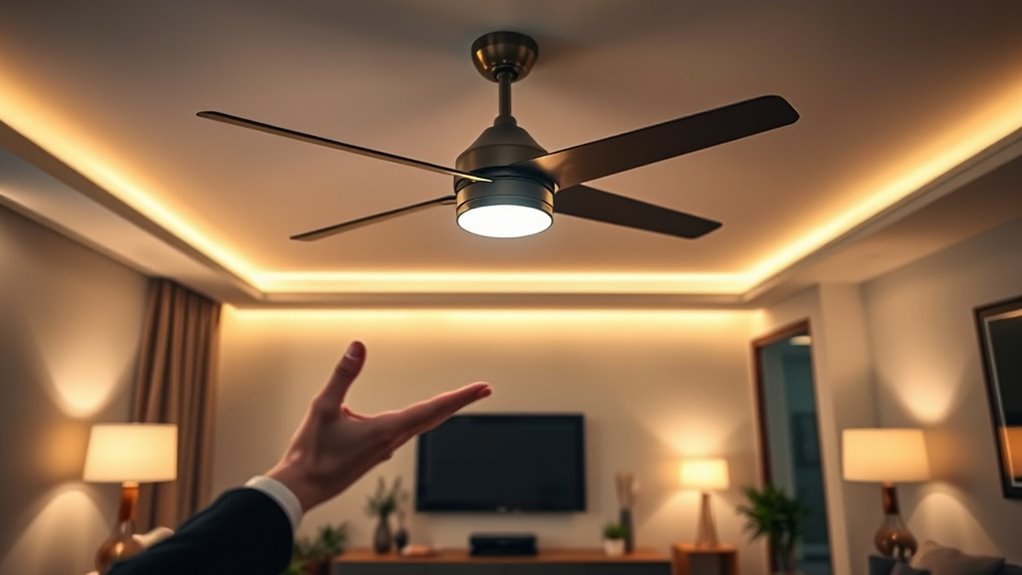Voice commands make controlling your smart ceiling fan easy and hands-free through virtual assistants like Alexa, Google Assistant, or Siri. You can ask your fan to change speed, adjust lighting, or set schedules seamlessly. The system processes your commands via Wi-Fi, ensuring quick responses and smooth operation. Connecting your fan to a compatible smart platform allows for personalized routines and integrated home automation, offering more control—explore further to unleash all the possibilities.
Key Takeaways
- Voice commands enable hands-free control of ceiling fan speed, oscillation, and lighting via virtual assistants like Alexa or Google Assistant.
- Compatible smart ceiling fans connect to Wi-Fi and integrate with voice platforms through dedicated apps for setup.
- Users can create routines or scenes for complex commands, such as “Good morning,” to automate fan functions.
- Cloud-based processing ensures real-time interpretation of voice commands for quick, responsive control.
- Voice control enhances convenience, energy efficiency, and seamless integration within broader smart home ecosystems.

Smart ceiling fans with voice command capabilities are revolutionizing how you control your home’s comfort. Instead of reaching for a wall switch or using a remote, you can now adjust your fan’s settings effortlessly through simple voice commands. This integration leverages voice recognition technology, typically via virtual assistants like Amazon Alexa, Google Assistant, or Apple’s Siri, enabling seamless interaction with your smart home ecosystem. When you speak, your voice commands are picked up by the microphone embedded in the fan or connected smart devices, processed in real-time, and translated into specific actions. This setup not only enhances convenience but also encourages energy efficiency, as you can fine-tune your fan’s operation without interrupting your activities. Voice control technology is continually advancing, making these systems more intuitive and responsive. To get started, you need a compatible smart ceiling fan equipped with voice command features or a hub that connects traditional fans to voice assistants. Once installed, you’ll link the fan to your Wi-Fi network and synchronize it with your preferred voice platform through a dedicated app. This process involves a few straightforward steps: opening the app, adding the device, and assigning it to a designated room or zone. Once configured, you gain access to a range of commands that can control fan speed, oscillation, lighting (if integrated), and even scheduling. For example, you might say, “Alexa, turn the ceiling fan to high,” or “Hey Google, set the fan to medium speed,” and the system responds instantly.
The technical architecture behind this functionality is based on cloud processing. When you issue a command, it’s transmitted via your Wi-Fi to the cloud servers of the voice platform. The servers interpret your request, verify the device’s capabilities, and send a command back to the fan. This process occurs within seconds, providing a smooth, responsive experience. Many systems also support custom routines or scenes, allowing you to create complex commands, such as “Good morning,” which could turn on the fan, adjust the light, and set a specific speed all at once.
Frequently Asked Questions
Can Voice Commands Operate Multiple Fans Simultaneously?
Yes, voice commands can operate multiple fans simultaneously if your smart home system supports it. You simply need to specify which fans you want to control or group them together in your app. For example, saying “Turn on all ceiling fans in the living room” activates all designated fans at once. Make sure your smart system is configured correctly, and your voice assistant can recognize the group commands for seamless multi-fan control.
What Voice Assistants Are Compatible With Smart Ceiling Fans?
In a blink of an eye, you’ll find that popular voice assistants like Amazon Alexa, Google Assistant, and Apple’s Siri seamlessly work with most smart ceiling fans. These platforms enable you to control fan speed, toggle on/off, and set schedules via simple voice commands. Compatibility depends on your fan’s smart features and the hub or app integration. Make sure your devices are connected to the same Wi-Fi network for smooth operation.
How Secure Are Voice Commands for Controlling Fans?
Voice commands for controlling fans are generally secure, but your safety depends on proper setup. You should use strong, unique passwords and enable two-factor authentication on your smart home accounts. Make sure your Wi-Fi network is secured with WPA3 encryption. Regularly update your device firmware to patch vulnerabilities. Be cautious about voice activation in public spaces, and disable voice control when not in use to prevent unauthorized access.
Can Voice Control Be Used Offline?
Imagine a smart fan as a loyal but sometimes stubborn friend. Offline, voice control works like giving commands to a friend in the same room—no internet needed. Many smart fans with local voice recognition process commands directly on the device, ensuring privacy and functionality without Wi-Fi. However, some advanced features still require an internet connection, so check your model’s specs to see if offline control suits your needs.
Are There Customizable Voice Commands for Fans?
Yes, you can customize voice commands for your smart ceiling fan. Many systems allow you to create personalized phrases or routines through their app or voice assistant settings. This flexibility lets you tailor controls to suit your preferences, making commands more intuitive. Check your specific device’s app for customization options, and verify your voice assistant supports personalized commands so you can easily adjust fan settings with phrases you prefer.
Conclusion
With voice commands, controlling your smart ceiling fan becomes effortless and intuitive, seamlessly fitting into your daily routine. But as technology evolves, new features and integrations are just around the corner—promising even smarter, more responsive control. Imagine a future where your fan responds instantly to your needs, adjusting perfectly without lifting a finger. Stay tuned, because the next step in smart home automation is just on the horizon, ready to transform your living space in ways you never expected.









